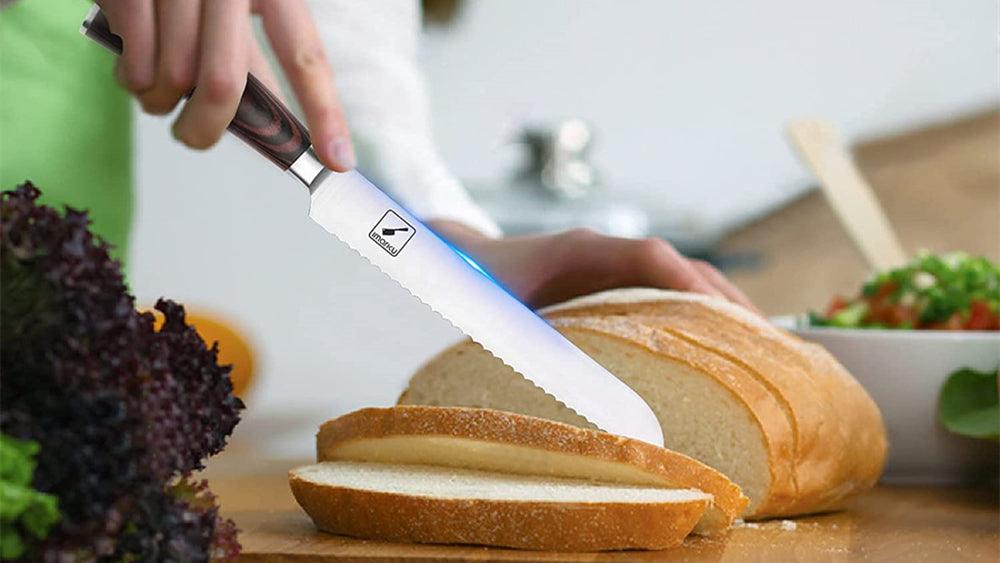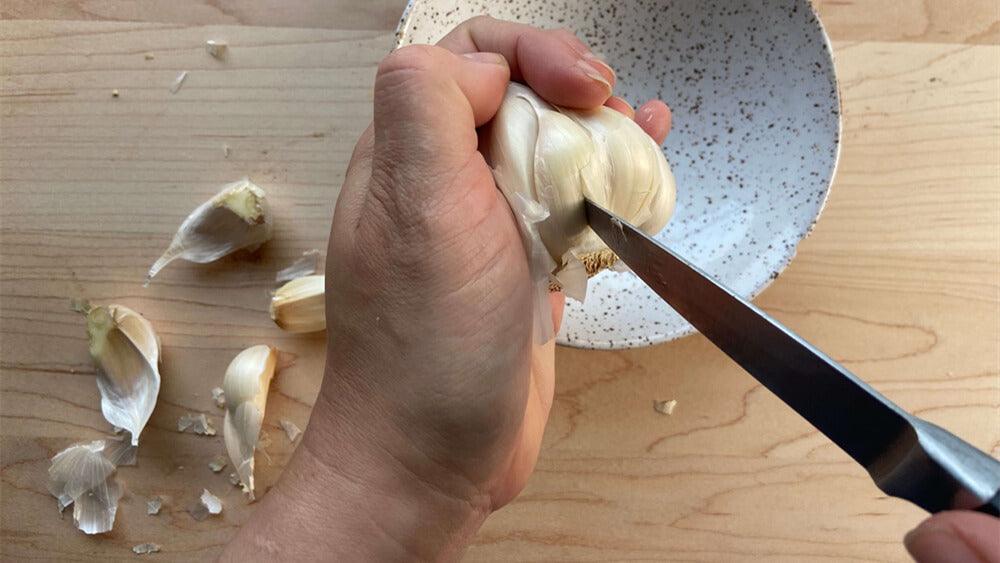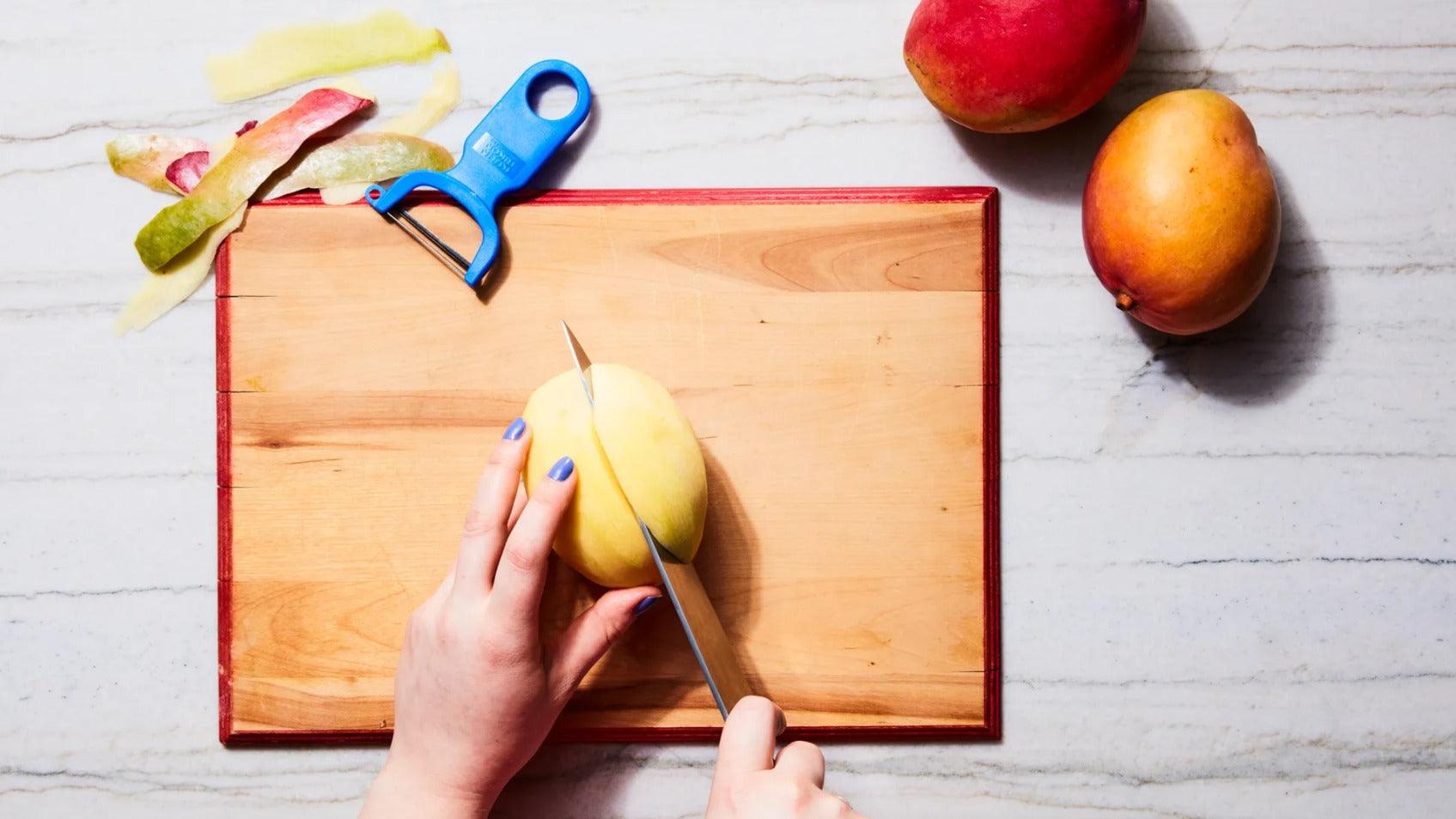TABLE OF CONTENTS
Currently, we’ve got a wide range of kitchen knives suiting different tasks. While choosing the appropriate knife sets for your kitchen, it’s vital to understand that you only need three quality knives to accomplish most kitchen tasks - a chef’s knife for your general chopping, a serrated or bread knife, and a paring knife for your hand-held precision cutting.
The bread knife is essential in your kitchen to achieve various tasks. Apart from cutting slices from hard crust loaves of bread, it can help you prepare hard-squishy food combos. You can easily cut or prepare these hard-squishy foods using the bread knife. When using it, you have to move the serrated piece front and back through the foodstuff.
Moreover, you can use the knife to slice your pineapples, cut your vegetables with rinds, or tough outer skins that may resist some blades. Cutting your tomatoes or paper-thin slicing becomes very easy when using the bread knives. However, many individuals are stuck on the appropriate choice between the serrated edge and straight-edged bread knives for the different kitchen needs. Read through the article to understand more about finding the best bread knife.
The serrated bread knives are the best alternatives over the straight-edged ones. When finding the best bread knife, it’ll be good to consider the number and shape of the serrations as they affect its functionality. Experts advise you to avoid scalloped serrated bread knives.
Besides, choosing the knife with a longer blade will be imperative to enhance functionality and durability while using the bread knife.

The Best Bread Knife Has a Specific Serrated Edge
When choosing the right bread knife, it’ll be imperative to choose one with a specific serrated edge. It’s a suitable choice for slicing and cutting through different foods. For instance, they’re the best cutlery for cutting foods with a soft interior and hard exterior like crusty loaves of bread. When cutting the bread, you’ve to sink the teeth-like edges into the loaf; then use saw-like movements to slice through the food.
The serrated blade is the better alternative to a blade with a sharp edge. The sharp-edged bread knife may end up compressing your loaf’s interiors. In contrast, most serrated-edged bread knives come with moon-shaped or chiseled gullets and beveled indentations. These features make the cutlery less destructive and precise than those with angled teeth. Furthermore, the gullets cut through the foods without tearing or ripping, creating less friction and allowing the flat blade to move in all directions while cutting.
Apart from the hard foodstuffs, the serrated knives offer a proper alternative for cutting slippery and squishy food or ingredients like tomatoes. The serrated features allow you to pierce through the tomato skin more quickly than most knives, except the Santoku and Chef’s knives.
Additionally, the serrated knives come with lower maintenance, requiring less sharpening. When using the sharp-edged cutlery, you’ll have to sharpen them every six months to enhance their performance. However, you don’t need to sharpen the serrated ones regularly. When using them, the sawing motion doesn’t put your knife under the same chopping conditions or demands as others. Significantly, their indentations glide through your foods, and the sharp points perform the hard work. The serrated features make them efficient and effective for kitchen needs.

Types of Serrations
When looking for the best-serrated bread knife, the number and shape of serrations are vital features to consider. These features affect how the blade will cut through the foods or ingredients. We’ve got different serrations on the knives, where some have beveled scalloped tips that resemble teeth. Some have more beveled bites and aggressive concave, making sharp points.
In addition, we’ve got some with a huge number of tiny serrations, while others come with reduced serrations; thus, creating wider gullets. When looking for an appropriate serration, the wider gullets make the better option. The gullets impact how the bread knife performs and how smoothly it achieves the cutting for different kitchen tasks.
Choosing the bread knives with wider and bigger gullets will be imperative for making greater cuts as it allows the blade to travel effortlessly while cutting the foods. It may also be the best alternative for meat lovers for grabbing and slicing different types of meats into thin layers.

Blade Shape
The blade’s shape is a vital consideration when choosing the right knife, as it affects how you use it and its performance. The bread knives come in three distinct shapes that suit different cutting needs. Below are the common bread knife shapes available:
● Offset
It’s a standard serrated blade that extends and drops approximately one or two inches below the handle. This bread knife design provides you with a knuckle clearance, essential to prevent your fingers from dragging along the board while making the final saw reach the bread’s bottom crust. Most offset knives are usually shorter, averagely 6-9 inches. The shorter length makes it hard to cut through a huge loaf of bread and makes it hard to cut the bread precisely.
● Curved
The curved bread knives offer the best alternative if you’ve got a knuckle clearance and you require more control over the knife’s movement. Notably, the blade’s shape will be essential when having a rocking motion while cutting through the fruits or vegetables.
● Flat
The flat-shaped bread knife blade is the most classic and popular shape among most manufacturers. The knife lacks curves or offsets, making it an appropriate option for making level cuts. It achieves the level cuts as the entire blade simultaneously reaches the last bit of the food.

What to Look For
When choosing the best blade, it’ll be vital to consider a thin and high-quality stainless blade with an approximate 10-inch blade, as it offers more versatility. The sizable serrated blade provides a better alternative for a huge loaf of bread. It enhances the appropriate dexterity you require when slicing your eggplant. The blade also helps you save time you’d spend sawing a longer blade forth and back.
Chiefly, choose a thin and long blade for kitchen tasks. Most manufacturers place this vital feature on either side of the bread knives due to the beveled serrations. Thick blades won’t be a suitable option, as they easily veer off to one side while cutting your foods, resulting in uneven slices. More so, the thinner your bread blade, the easier it’s to make skinny tomato slices.
When looking for the best bread knife, narrowing your research on the high-carbon stainless steel and sturdy blades is imperative. They’re the best alternatives as they offer durability and hold their angle longer after sharpening the serrated bread knife. Experts advise on this alternative as it may not be easy to resharpen the serrated bread knives, saving you the cost and time of maintaining them.
When looking for the right knife, it’ll be good if you avoid the scalloped serration feature on the blade. These features prevent the blade from grabbing your foods immediately and pricing the crust, making you get a lot of crumbs and flaking on the cutting board.
Significantly, choose the blade with broad and deep gullets ending up in pointed tips to allow the effective working of the knife. Lastly, blades with more serrations or irregularly-shaped gullets aren’t the better alternatives, as you’ve to spend more time sharpening them.

Form and Function
Depending on the design, we’ve got various forms and functions of the blades. Some designs drop and extend the blade, while the most prevalent ones have the blade in line with their handle. It’ll be vital to consider the bolster when choosing the right blade based on functioning, as it’s an essential safety feature.
The bolster protects your fingers from the serrations, which might lead to blisters. When checking the best safety or bolster, it’ll be good to avoid a bulky or thick protective. Notably, consider a bolster that can help you achieve your tasks and the knife’s control while having a comfortable forefinger or thumb, such as the sloped bolster.
The best option should offer a balance between functioning and comfort. The knife’s blade shouldn’t be heavier than its handle or vice versa when you’re grasping or using the knife. Choosing full tang cutlery will be wise to enhance the knife’s balance, as the tang allows the steel to extend through the handle.
Lastly, consider cutlery with an ergonomic handle. The ergonomic handle design is a great feature that helps you work comfortably when using the piece and enhances the blade’s total control. Furthermore, it’s a design favoring non-slip practicality more than aesthetics. With the need for regular washing, it’ll be good to choose a blade you can hand wash over a dishwasher-safe knife.

Bread Knife Recipe Test
A bread knife deserves a place in your kitchen due to its ability to perform various kitchen tasks. For instance, you can use it to prepare any combo in your kitchen, like extra-thick crunchy crust with overripe tomatoes. The serrated bread knife will help you achieve the combo as its features allow it to handle or deal with tough outer bread crusts and even ripe tomatoes.
Before choosing your knife, it’ll be imperative to consider having a recipe test to get the appropriate alternative. You can test various serrated knives using tomatoes and bread to get the best knife. Notably, the best option for your kitchen tasks should have a large blade, an averagely 10-inch long, sloped bolster, an outstanding balance between the handle & blade, and one with quality Japanese steel.

Conclusion
Bread knives are essential cutlery in your kitchen, as they help you achieve different kitchen tasks, from slicing crusty loaves of bread to piercing tomatoes. With the wide variety of knives available, a serrated bread knife is an appropriate alternative for most kitchen tasks, as they help you achieve precise cutting and offer durability. Importantly, you’ll need to consider the type of serrations, blade shape, form, and function to get the best bread knife for your cutting tasks.






















Leave a comment
All comments are moderated before being published.
This site is protected by hCaptcha and the hCaptcha Privacy Policy and Terms of Service apply.